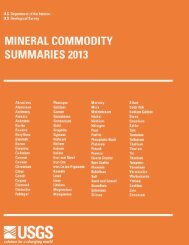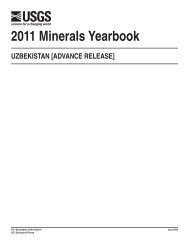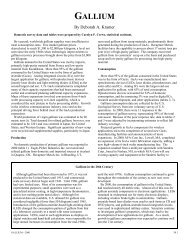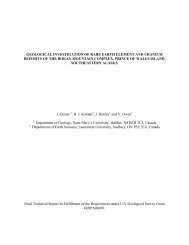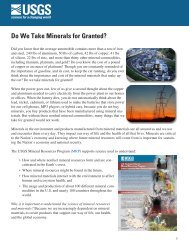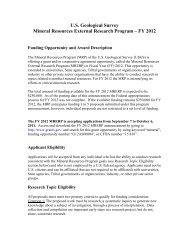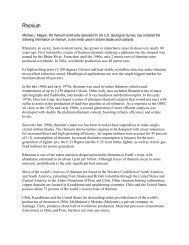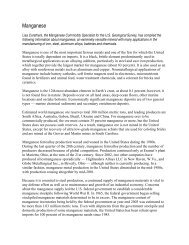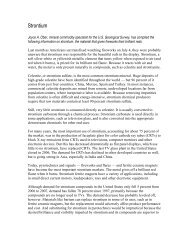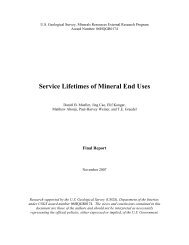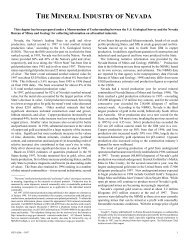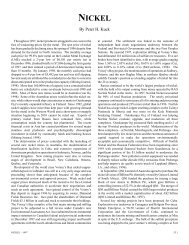Mineral Commodity Summaries 2003 - Mineral Resources Program ...
Mineral Commodity Summaries 2003 - Mineral Resources Program ...
Mineral Commodity Summaries 2003 - Mineral Resources Program ...
Create successful ePaper yourself
Turn your PDF publications into a flip-book with our unique Google optimized e-Paper software.
SAND AND GRAVEL (INDUSTRIAL)<br />
Events, Trends, and Issues: Domestic sales of industrial sand and gravel in 2002 decreased by about 2% compared<br />
with those of 2001. U.S. apparent consumption was 26.6 million tons in 2002, increasing slightly over the previous<br />
year. Imports remained about the same as those of 2001. Imports of silica are generally of two types: small-quantity<br />
shipments of very-high-purity silica or a few large shipments of lower grade silica that were shipped only under special<br />
circumstances (e.g., very low freight rates).<br />
The United States was the world’s largest producer and consumer of industrial sand and gravel based on estimated<br />
world production figures. It was difficult to collect definitive numbers on silica sand and gravel production in most<br />
nations because of the wide range of terminology and specifications for silica from country to country. The United<br />
States remained a major exporter of silica sand, shipping sand to almost every region of the world. This was attributed<br />
to the high quality and advanced processing techniques for a large variety of grades of silica, meeting virtually every<br />
specification for silica sand and gravel.<br />
Domestic production and apparent consumption is estimated to be about 28 million tons and 27 million tons,<br />
respectively, in <strong>2003</strong>.<br />
The industrial sand and gravel industry continued to be concerned with safety and health regulations and<br />
environmental restrictions in 2002. Local shortages were expected to continue to increase owing to local zoning<br />
regulations and land development alternatives. These situations are expected to cause future sand and gravel<br />
operations to be located farther from high-population centers.<br />
World Mine Production, Reserves, and Reserve Base:<br />
Mine production e<br />
Reserves and reserve base 2<br />
2001 2002<br />
United States 27,900 28,000<br />
Australia 2,500 2,500 Large. Silica is abundant in the Earth’s<br />
Austria 5,800 5,800 crust. The reserves and reserve base<br />
Belgium 2,400 2,400 are determined mainly by the location of<br />
Brazil 2,700 2,700 population centers.<br />
Canada 2,000 2,000<br />
France 6,600 6,600<br />
Germany 6,800 6,800<br />
India 1,400 1,400<br />
Italy 3,000 3,000<br />
Japan 2,500 2,500<br />
Mexico 1,700 1,800<br />
Netherlands 3,000 3,000<br />
South Africa 2,100 2,100<br />
Spain 6,000 6,000<br />
United Kingdom 4,000 4,000<br />
Other countries 15,000 15,000<br />
World total (rounded) 95,000 96,000<br />
World <strong>Resources</strong>: Sand and gravel resources of the world are sizable. However, because of their geographic<br />
distribution, environmental restrictions, and quality requirements for some uses, extraction of these resources is<br />
sometimes uneconomic. Quartz-rich sand and sandstones, the main source of industrial silica sand, occur throughout<br />
the world.<br />
Substitutes: Silica sand continues to be the major material used for glassmaking and for foundry and molding sands;<br />
alternatives are zircon, olivine, staurolite, and chromite sands.<br />
e Estimated. E Net exporter. NA Not available.<br />
1 Defined as imports - exports + adjustments for Government and industry stock changes.<br />
2 See Appendix C for definitions.<br />
145<br />
U.S. Geological Survey, <strong>Mineral</strong> <strong>Commodity</strong> <strong>Summaries</strong>, January <strong>2003</strong>



